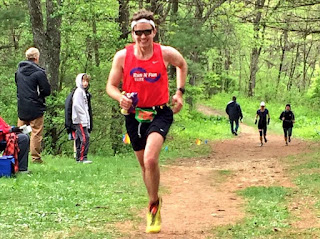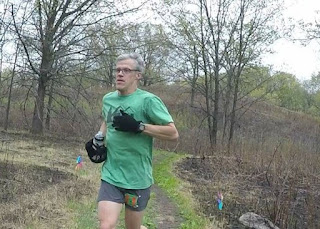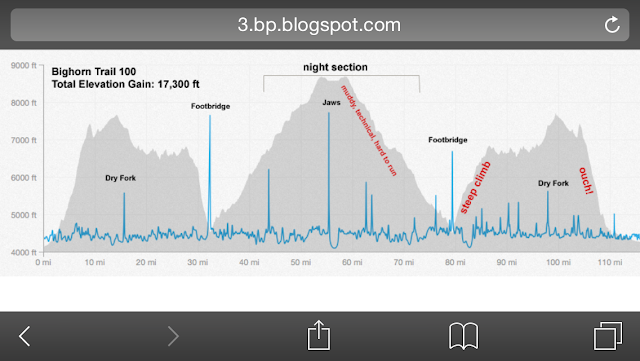A special year for a special race! The Ice Age Trail 50
was the first 50-mile ultramarathon in the Midwest. And now, 35 years
later, it stands as one of the oldest, continuously running 50-mile races in
the country.
If you haven’t already heard the story, the Ice Age
Trail 50 was conceived by ultrarunner Tom Ulik and Badgerland Strider’s
President Glenn Wargolet in a Milwaukee tavern back in 1981. Focused more
on the logistics of staging a 50-mile race (an unusual distance at the time),
Glenn (RD 2005-09) imagined a one-mile loop course in a Milwaukee County
park. Tom (RD 1982-86) had a different idea. He invited Glenn to
a run in the Southern Kettle Moraine Forest — and that’s all it
took. The first Ice Age Trail 50 happened less than a year later.
All three of the Ice Age runs take you
through scenic, historic, and geologically fascinating areas with natural
features left when the glaciers finally retreated from Wisconsin more than
10,000 years ago. The courses pass by sites that provide a glance
into the lives of the area’s first settlers and climb Bald Bluff, a place
revered by Native Americans and the location of the Black Hawk War, the last
major Indian war in Wisconsin. Included among the 3,500 soldiers who camped
beside the bluff were two future US Presidents, Abraham Lincoln and Zachary
Taylor.
If you like fast company, you’ll find it at Ice
Age. In 2014, Max King from Bend, Oregon ran the 50-mile race
in 5:41, smashing our 26-year old course record by 12 minutes —
and Kaci Lickteig from Nebraska bettered the women’s CR by four minutes,
running 6:41. In fact, four runners ran under six hours in
2014, which is remarkable in that only five other runners had run sub-6s
in the preceding 32 years!
The 2016 Race!!
Let the fun begin!! In celebration of the 35th
year of The Ice Age Trail Race the Badgerland Striders are offering a $5,000
cash prize to any runner (male or female) who can set a new course record,
& $200 prize bonuses for age division records in the 50-mile race. This year while the competition for course
record may not be as deep, it will no doubt be fast! There is also a great side story this year
showcasing longevity in the sport and with this race, with 1 runner aiming for
his 30th finish (1st in race history), and 3 more going
for 25 (Currently there are 3). There
are also 8 previous winners of the 50 mile race returning to the event to run
various distances and partake in the after party sharing stories of the past! Lets
take a look at the front runners and those looking to showcase lifetime
endurance!
Men Front
Runners
Tyler Sigl
(Wisconsin Runner/USANA Health Sciences) – A WI native who is no stranger to
speed, he has a current marathon PR of 2:17, a road 50k PR of 3:09, and a trail
50 mile PR of 5:27. To say he has the
leg speed and the mental strength to not only win Ice Age Trail 50 mile, but to
crush a course record and walk away with $5,000 would not be a stretch. He recently ran that 50K PR so he is fit. He has experience running these types of
trails as he has won 3 consecutive North Face Endurance Challenges in Southern
Wisconsin. As long as the course co-operates
and the competition can help push him it should be an exciting show to watch!
Devin Clark
– Illinois native Devin is young and newer to running ultras but not new to
running fast. While only 20 years old he
holds a 5k PR of 15:19, and has run a 6:59 50 mile and 3:39 50K on the
trails. He is currently being coached by
Chris Vargo, who believes he has the current fitness for a 2:16 marathon. If that is truly the case look for Tyler and
Devin to spend quite a bit of time on the trails together.
Chase Nowak
– From Minnesota Chase is another runner who has run a 4 ultras, winning 3 and
taking 2nd in the other! With a 3:30 trail 50k PR and a win at the
superior trail 50 mile, he not only has the speed to kill the flats but the
strength to really push the hills.
Whether he decides to hang with an aggressive pace early or hang back
and close hard will shape the picture of the race.
Kevin Grabowski
(LPTR) – A local runner Kevin has been running fast for a long time. Kevin managed to run himself into the top ten
at Ice Age in 2014 when Max set the CR.
Around that time frame he also managed to run a 7:17 100K at the age of
45! Kevin has run a lot of Ultras and
rarely will you see him out of the top 10, if not the top 3. Lately he has been training hard towards an
early summer 100 miler and his fitness is good.
At the turns if Kevin is hot on the heals of any the front runners, they
better not let the gray hair fool them, he will close hard and fast!
Joel Lammers
(LPTR) – To speak of running fast, racing a lot (of Ultras), and consistently winning
or standing on the podium in Wisconsin is to speak of Joel. At the age of 53 Joel has run over 100 ultras
and he continues to not only place but win them. Joel last won the Ice Age Trail in 2008. Since then he has finished 46 ultras, won 6
of them and podiumed at 16 of them. Consistency
is Joel’s strength, look for him to start out slower and run faster as the day
goes. He is strong, knows the course,
and should the tables turn for those in front of him he will gobble them up.
John Knudson
– Coming from Illinois John, took a bit of a break from the ultra scene. But when he decided to come back last year
(2015) he managed to win the 50k he ran and take a 3rd place (behind
Tyler) at The North Face 50 mile WI.
John has some experience and the strength to push with the front group,
look for him to show up strong!
Ross Salinas
– Living in Iowa Ross has had a chance to really perfect himself at the 50K
distance, in fact if you look up his results (quite a few) he is either winning
them or on the podium. The 50 mile
distance has been a little rougher for him, but if he can really pull this one
together expect to see him near the top.
Adam Dohm - A runner from Minnesota has run 3 ultras
and podiumed at all of them. He recently
ran a 3:53 50K at The North Face in DC.
If that was a training race for Ice Age look for him to be able to bring
a bit more speed to his second 50 mile attempt.
Women Front
Runners
Larisa Dannis
(Hoka One One/INKnBURN) – Now living in California, Larisa is an athlete best
known for having an awesome time on the trail while making running fast look so
easy! Prior to the last time she raced Ice Age, in 2014 where she took 3rd
place, Larisa had already won several big Ultras. That 3rd place earned Larisa a
ticket to race Western States 100, a race where she took second. She then went on to absolutely crush the Door
County 50 mile race in 5:59. Shortly
after that Larisa became injured and did not race again till the latter half of
2015, where she won almost everything she ran, including a 3rd place
at The North Face Championships in CA.
If Larisa is feeling good, look for her to be running happy, and if
Larisa is running happy she can be scary fast and may just snag not only a win
but $5,000!
Janessa Taylor
– Coming from Oregon Janessa has run 23 ultras and won a lot of them. Most recently Janessa took 2nd at
the Bandera 100k in 9:40 and won the Antelope Island 50 mile in 7:18. She dipped under the 7 hour 50 mile time last
summer with a 6:51. Janessa has the
speed and she knows how to win. If
Janessa and Larisa can run together in the beginning look for a strong battle
for the win and a hard push for that CR bonus!
Becky Kirschenmann
– Becky last ran Ice Age in 2005. Then she
decided to move west and crush very long hard races. In the last 2 years alone Becky has one the
Desert Rats Stage Race 148 miles (twice), Trans Rockies 120 miles, Pine to Palm
100 mile, and the Zion 100k. Recently
Becky placed 5th at the Run Rabbit Run 100 mile. She has also been able to creep under the 8
hour mark at the Siskiyou Out Back 50 mile.
Becky obviously has the endurance and lungs to hang with the front end
of the race, it will only be a matter of the pace her legs need to go. With her determination, and ability to win,
look for her to be on the podium.
Christine
Crawford (Pearl Izumi/LPTR) – A local Wisconsin runner Christine has
been at the Ultra game for 15 years. In
that time frame she has managed to run almost 100 Ultras and win or podium in
almost all of them. Most of those wins were so fast she also podiumed overall
and won a few outright! For a long time
there were very few men in the Midwest who were not scared of Christine showing
up at a race, for it surely signaled they would be chicked. In the last few years Christine has battled
through some injuries, but is now back to running fast and having fun doing
it. Christine has won Ice Age 3 times,
so she not only knows the course but how to win on it! If she is having a great day and really
smiling, look out because at the young age of 46 she can run all the young
girls and most of the guys down!
Carolyn Smith
– Another past winner of Ice Age and Wisconsin resident is Carolyn Smith. Carolyn is probably more widely known for
representing the USA in Multiple world championships at various long distances.
She most recently has gone as fast as 6:28 in the 50mile distance at the age of
49. With her stamina, mental strength, and now over the age of 50, Carolyn
resetting the 50-54 age record should be a lock, and depending on how her race
unfolds you may find her on the podium. (Update - Carolyn will not be running due to injury)
Meghan Kennihan
– Meghan is an Illinois runner who ran to a 5th place at last year’s
Ice Age. She followed that up with a win
at the Kettle Moraine 100k and the Cry me a River 50 mile. Meghan knows how to win and how to run hard. She has the endurance to hit the podium and
depending on the day crash the party and win the race!
Historical Runners
30 Years 1500
Miles
Andy Arena
– Andy Arena is the ironman of the Ice Age Trail 50 mile race. This year, at the age of 65, Andy will be
going for his 30th finish!
That’s incredible! Andy has a long history with one of the oldest trail
ultras in the country. He has seen every
running fad in the last 40 or so years come and go, and he’s still
running. We wish Andy all the best and
will be cheering loudly for him at every aid station.
25 Year 1250
Miles
Parker Rios
– At the age of 49 Parker has Ultra finishes and Podiums going back over 25
years. When things get really tough and
brutal (think Badwater 135 or Arrowhead 135) Parker really shines. To really demonstrate this toughness in 2014
Parker took 2nd in the Iditarod Trail Invitational, where he pulled
a sled across a frozen Alaska for 5 days!
Unless Parker dies on the course we should all be able to cheer him in
for his 25th Ice Age finish!
Tom Balzola
– At the age of 72 most people can barely fathom running 50 meters, yet Tom is
not only thinking about running 50 trail miles he is doing it! We Wish him all the best and cannot wait to
hand him his 25 year buckle!
Andrew
Klapperich – the 58 year old Wisconsin native has consistently finished
the Ice Age 50 mile since his early 30’s.
Expect no less from him this year and congratulate him when you see him
at the finish, holding his new 25 year buckle!
Past Winners
Here are a few of the races winners who have won multiple
times and are joining the fun at different distances. If you see them pre, during, or post race,
hit them up for some incredible stories you wouldn’t even believe possible
regarding the beginnings of the race and trail ultra running in this country!
Steven Szydlik
– Steven won The Ice Age Trail and astounding 8 times!
Bob Telfer
– A decade ago in 2006 Bob was the 1st individual to reach 25 Ice
Age finishes!
Clement Grum
– Clement won Ice Age 5 times and incredibly holds the current 35-39 Age Group
record with a time of 5:59, set in 1993 23 years ago!!(Update - Clem is not running)
This race should be fun and fast as always. Also the after party, where the stories will be
even grander this year, will be the place to be. If you will not be able to make to the Southern
Kettle Moraine Forest for this year’s Ice Age Trail Races (The 35th
year) you will be able to follow along. I will be providing live updates on twitter at both my personal site
(@nmwied) and the Ice Age Trail Race Site (@IceAgeTrail50), and periodically
the Ice Age Trail 50 Facebook Page .
I will also be completing a race results summary.






















